
» KEY POINTS
- Having just over 52% of the popular vote demonstrated that then President-elect Joe Biden did not have a mandate from the people.
- However, he was not alone as very few Presidents have ever had more than 55% of the popular vote.
- From a Presidential race perspective, we are not any more divided today than any other point in history.

Now, this campaign is over. What is the will of the people? What is our mandate?
... I believe that this is part of the mandate given to us from the American people.
Excerpts from President Elect Joe Biden’s victory speech, November 7, 2020
Then president-elect Joe Biden believed he had the will of the people. Or, in his words, he had a “mandate” to govern and perform in a certain way. While there is no reasonable, fact-based, reality-grounded argument that showed that Mr. Biden did not win the 2020 Presidential election, that is far and away from saying he had a mandate from the people.
By mid-December 2020, standing President and first-runner-up Donald Trump had amassed over 74.2 million votes in his favor according to the Cook Political Report National Vote Tracker. While this paled in comparison to the over 81.3 million for Mr. Biden, it did confirm there was a massive pool of people who voted against Mr. Biden. Additionally, there were another 2.9 million people who voted for neither candidate. All told, Mr. Biden had about 52% of the vote among those who actually cast a ballot.

And of course, that is the rub. According to the United States Census Bureau, there were approximately 235.4 million people over the age of 18 in the United States at the end of 2019. Using that number as the denominator, Mr. Biden had less than 35% of the voting-age population cast their ballots for him (never mind people who are not eligible to vote due to debatable State and Federal laws). Now, to be fair, plenty of people who did not vote may have voted for him anyway but were in a noncompetitive State—one way or another—and therefore were dis-incentivized to vote. On the other hand, plenty of people also voted for him not out of preference, but out of dis-preference for Mr. Trump and the other options.
Suffice to say, no matter which way you slice it, Joe Biden did not have a clear mandate of the people. But this is no indictment against him nor a challenge to whatever his agenda may be. On the contrary, this is a defense of these results because:
No President in history has ever had the will of the people.
First off, let us take a look at “modern elections”. We already know there are two elections—2000 and 2016—where the eventual Electoral College winner did not receive the majority of the popular vote. In 2000, the winner George W. Bush received 47.9% of the popular vote compared to first runner up Al Gore who received 48.4%. Similarly, in 2016 Donald Trump received 46.1% to Hillary Clinton’s 48.2%. Yet, are these numbers that different than other recent elections?
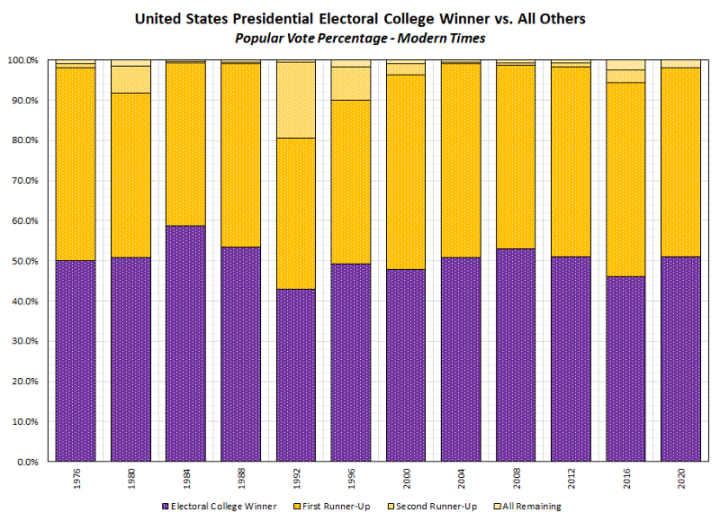
The chart above (and all other charts in this story) shows the popular vote percentage for the Electoral College winner in purple, the first runner up in orange, and second runner up in a lighter orange/yellow, and all others in a pale yellow; or in ever lightening shades if viewing in monochrome. As can be clearly seen, in the 12 elections since 1976, only one saw a candidate even get close—but not surpass—60% of the popular vote. In other words, we are a divided nation, at least when it comes to electing a President. The results are no different than any other election in our recent past.

Just to be clear how little mandate the Presidents have had, in Bill Clinton’s first term in 1992 he received just 43.0% of the popular vote (the fourth lowest in history). At the same time, in the end he received 68.8% of the Electoral College vote! Even in his second term election four years later his popular vote percentage did not reach half the voters, petering out at 49.2%. The best results over the “modern” timeframe go to Ronald Reagan’s second term in 1984 with a whopping 58.8%. Other than that, every other election has been around or below 50%—whether it was Barack Obama, George H.W. Bush, Jimmy Carter, or anyone else.
Thus far, then, we can see that—at least recently—there has been a clear divide. No eventual winner in modern times has carried a true super majority of the people. But what about for all time?

Well, this is where things get a bit complicated. Sure, you could say in 1820 James Monroe received 80.6% of the popular vote. Or you could look at the opposite direction for the next election in 1824 where the House of Representatives picked John Quincy Adams to be the President even though he lost both the popular and Electoral College votes (30.9% and 32.2%, respectively). However, we need to remember a few things. First off, large swaths of Americans—people of color, women, natives, non-landowners—were barred from voting in general. Next, widespread use of popular voting to determine the actions of Electors did not come until later. For that, we need to zoom in on the point after the last time the people did not directly vote for President: the 1876 vote where Colorado’s Legislature chose instead of the people.

All right, we still know that people were being disenfranchised from their vote (and many still are), but at least we have a viable comparison point of all States picking their Electors based upon the results of that popular vote. And what happened right away in that first election? James Garfield barely squeaked by with just 48.3% of the popular vote, a dead heat with his main competitor Winfield Scott Hancock. While accuracy in the count is not as verifiable as today, it is safe to say the margin between the two was less than 2,000 votes. However, just as today, Mr. Garfield was able to take 58.0% of the Electoral College votes just because of which States he carried, not how many people voted for him across the entire nation.
And similar to today, there were fights over fairness and who had a mandate and what Presidents thought the people told them to do. Since 1880, the average popular vote percentage for the eventual winner has been 52.1%, including the unofficial 2020 counts. Over the 36 elections since 1880, only 10 (27.8%) have had the Electoral College winner carry 55.0% or more of the popular vote. If we look at all 59 elections, that number only jumps up another small bit to 15 (25.4%). And even among those, in elections after 1820 only 4 have seen popular vote numbers break 60%—Warren Harding in 1920, Franklin Roosevelt (second term) in 1936, Lyndon Johnson in 1964, and Richard Nixon (second term) in 1972. Since then, not a single candidate has cracked that barrier.

That is right, disgraced former President Richard Nixon was the last one who could have potentially said he had a mandate, or at least a clear majority of voters. He certainly swept the Electoral College with 96.7% of that vote. Ronald Reagan was the last president to perform as well as Mr. Nixon in the Electoral College. That said, while in 1980 and 1984 Mr. Reagan took 90.9% and 97.6% of the Electoral College, he still only had 50.8% and 58.8% of the popular vote, respectively. This is another reason why looking at political maps of the country that assign a single color to a State—like the one at the top of this chapter—are so misleading.
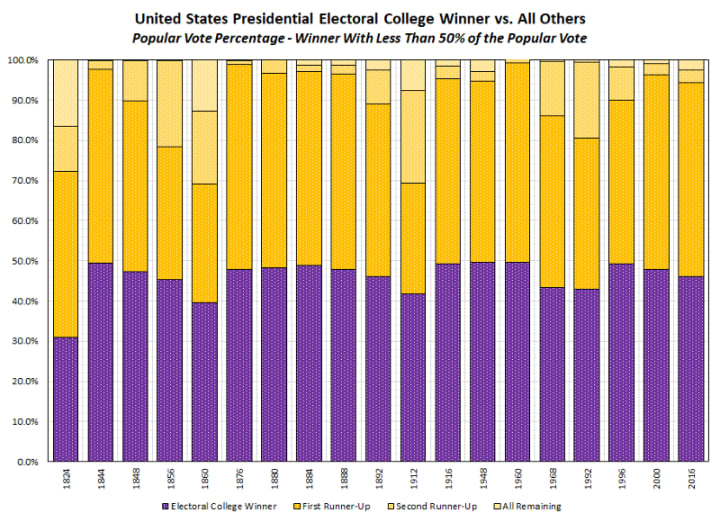
What is actually clear is that the opposite situation is more likely to happen. On 19 occasions (32.3%) the eventual Presidential winner had less than or equal to 50% of the popular vote. Thirteen (36.1%) of those have come since 1880. This includes the election of 1912 where Woodrow Wilson (first term) received just 41.8% of the popular vote—the least since Abraham Lincoln’s first term in 1860 with 39.7%. The aforementioned 1992 Election of Bill Clinton was the next one to come close to this low number.
After tumultuous elections in 1876 and 1880, things kept getting worse. This was a country that still had festering wounds from the Civil War. It did not help when, in 1888, Benjamin Harrison became the next President to win the Electoral College while losing the popular vote with 47.8% compared to incumbent Grover Cleveland’s 48.6%. The Electoral College, being what it is, awarded 58.1% of the vote to Mr. Harrison.
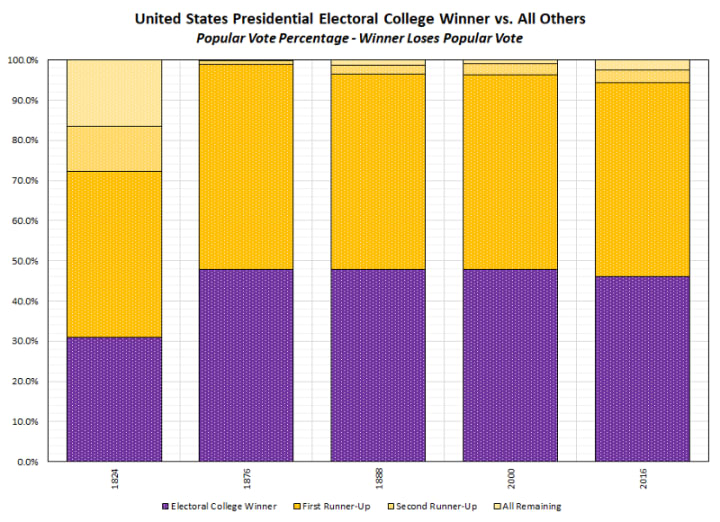
The next election would seem to make things worse when Grover Cleveland re-won the White House with just 46.0% of the popular vote to Benjamin Harrison’s 43.0% and James Weaver’s 8.5%. One could say this was a time even more split and separated than now, and the country could have easily fallen back into Civil War.
Despite the rhetoric of today, we are not nearly as divided as that. While there are chasms, they are not as insurmountable. Though people back then feared the worst was yet to come, circumstances actually shifted to more just solutions instead. Since that time, the 19th Amendment was ratified in 1920 that extended full voting rights to all sexes. In 1964, the 24th Amendment removed racist policies like a poll tax from being used to deny people the right to vote. Just a year later in 1965 the Voting Rights Act became the law of the land in an attempt to make sure all minority groups could not be denied their privileges to cast a ballot—and was further amended in 1970, 1975, 1982, 1992, and 2006. After that, in 1971, the 26th Amendment lowered the voting age to 18 for all elections in the country.

This is the story that demonstrates that as we have expanded voting rights to all people and more individuals have felt comfortable expressing their political opinions, we have not become any more divided. We are the same as many points in the past and—on average—throughout all history. No, then President-elect Joe Biden did not have a mandate, and should not have acted as if he did. However, he was not alone as no one in his position has ever had one. Times may feel like we are on the precipice and we could not be more at odds, but that is always true. There is no single person who can encompass and represent the dreams of a nation as vast and diverse as our own.
And, perhaps, that is for the best.

The above piece is an excerpt from Always Divided, Never United: And Other Stories During a Time of Pandemics and Politics by J.P. Prag, available at booksellers worldwide.
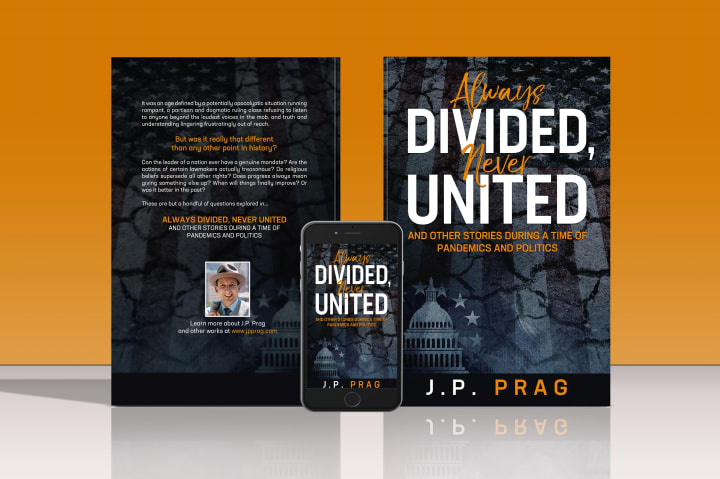
Learn more about author J.P. Prag at www.jpprag.com.
About the Creator
J.P. Prag
J.P. Prag is the author of "Aestas ¤ The Yellow Balloon", "Compendium of Humanity's End", "254 Days to Impeachment", "Always Divided, Never United", "New & Improved: The United States of America", and more! Learn more at www.jpprag.com.


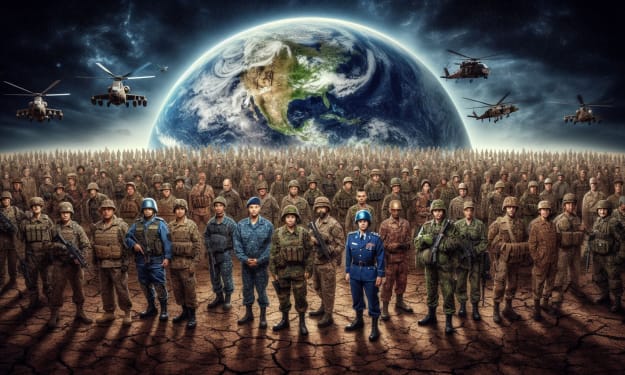



Comments
There are no comments for this story
Be the first to respond and start the conversation.